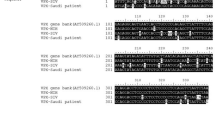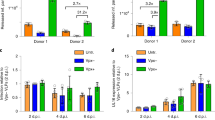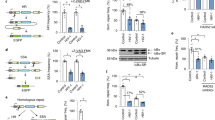Abstract
SAMHD1 restricts the infection of dendritic and other myeloid cells by human immunodeficiency virus type 1 (HIV-1), but in lentiviruses of the simian immunodeficiency virus of sooty mangabey (SIVsm)–HIV-2 lineage, SAMHD1 is counteracted by the virion-packaged accessory protein Vpx. Here we found that SAMHD1 restricted infection by hydrolyzing intracellular deoxynucleoside triphosphates (dNTPs), lowering their concentrations to below those required for the synthesis of the viral DNA by reverse transcriptase (RT). SAMHD1-mediated restriction was alleviated by the addition of exogenous deoxynucleosides. An HIV-1 with a mutant RT with low affinity for dNTPs was particularly sensitive to SAMHD1-mediated restriction. Vpx prevented the SAMHD1-mediated decrease in dNTP concentration and induced the degradation of human and rhesus macaque SAMHD1 but had no effect on mouse SAMHD1. Nucleotide-pool depletion could be a general mechanism for protecting cells from infectious agents that replicate through a DNA intermediate.
This is a preview of subscription content, access via your institution
Access options
Subscribe to this journal
Receive 12 print issues and online access
$209.00 per year
only $17.42 per issue
Buy this article
- Purchase on Springer Link
- Instant access to full article PDF
Prices may be subject to local taxes which are calculated during checkout





Similar content being viewed by others
Change history
04 April 2012
In the version of this article initially published, the number for Baek Kim's second affiliation is incorrect in the author list. The correct number is 10. The error has been corrected in the HTML and PDF versions of the article.
15 January 2013
In the version of this article initially published, the Author Contributions statement was incomplete. The correct statement should include the following: "C.T. raised the original idea that Vpx may increase the amount of nucleotides." The error has been corrected in the HTML and PDF versions of the article.
References
Sharova, N. et al. Primate lentiviral Vpx commandeers DDB1 to counteract a macrophage restriction. PLoS Pathog. 4, e1000057 (2008).
Hrecka, K. et al. Vpx relieves inhibition of HIV-1 infection of macrophages mediated by the SAMHD1 protein. Nature 474, 658–661 (2011).
Laguette, N. et al. SAMHD1 is the dendritic- and myeloid-cell-specific HIV-1 restriction factor counteracted by Vpx. Nature 474, 654–657 (2011).
Li, N., Zhang, W. & Cao, X. Identification of human homologue of mouse IFN-γ induced protein from human dendritic cells. Immunol. Lett. 74, 221–224 (2000).
Yan, N., Regalado-Magdos, A.D., Stiggelbout, B., Lee-Kirsch, M.A. & Lieberman, J. The cytosolic exonuclease TREX1 inhibits the innate immune response to human immunodeficiency virus type 1. Nat. Immunol. 11, 1005–1013 (2010).
Rice, G.I. et al. Mutations involved in Aicardi-Goutieres syndrome implicate SAMHD1 as regulator of the innate immune response. Nat. Genet. 41, 829–832 (2009).
Crow, Y.J. et al. Mutations in the gene encoding the 3′-5′ DNA exonuclease TREX1 cause Aicardi-Goutières syndrome at the AGS1 locus. Nat. Genet. 38, 917–920 (2006).
Zimmerman, M.D., Proudfoot, M., Yakunin, A. & Minor, W. Structural insight into the mechanism of substrate specificity and catalytic activity of an HD-domain phosphohydrolase: the 5′-deoxyribonucleotidase YfbR from Escherichia coli. J. Mol. Biol. 378, 215–226 (2008).
Vorontsov, I.I. et al. Characterization of the deoxynucleotide triphosphate triphosphohydrolase (dNTPase) activity of the EF1143 protein from Enterococcus faecalis and crystal structure of the activator-substrate complex. J. Biol. Chem. 286, 33158–33166 (2011).
Leshinsky-Silver, E. et al. A large homozygous deletion in the SAMHD1 gene causes atypical Aicardi-Goutieres syndrome associated with mtDNA deletions. Eur. J. Hum. Genet. 19, 287–292 (2011).
Bourdon, A. et al. Mutation of RRM2B, encoding p53-controlled ribonucleotide reductase (p53R2), causes severe mitochondrial DNA depletion. Nat. Genet. 39, 776–780 (2007).
Brahimi, N. et al. The first founder DGUOK mutation associated with hepatocerebral mitochondrial DNA depletion syndrome. Mol. Genet. Metab. 97, 221–226 (2009).
Diamond, T.L. et al. Macrophage tropism of HIV-1 depends on efficient cellular dNTP utilization by reverse transcriptase. J. Biol. Chem. 279, 51545–51553 (2004).
Woodside, A.M. & Guengerich, F.P. Effect of the O6 substituent on misincorporation kinetics catalyzed by DNA polymerases at O(6)-methylguanine and O(6)-benzylguanine. Biochemistry 41, 1027–1038 (2002).
Collin, M. & Gordon, S. The kinetics of human immunodeficiency virus reverse transcription are slower in primary human macrophages than in a lymphoid cell line. Virology 200, 114–120 (1994).
Furge, L.L. & Guengerich, F.P. Analysis of nucleotide insertion and extension at 8-oxo-7,8-dihydroguanine by replicative T7 polymerase exo- and human immunodeficiency virus-1 reverse transcriptase using steady-state and pre-steady-state kinetics. Biochemistry 36, 6475–6487 (1997).
Ueno, T., Shirasaka, T. & Mitsuya, H. Enzymatic characterization of human immunodeficiency virus type 1 reverse transcriptase resistant to multiple 2′,3′-dideoxynucleoside 5′-triphosphates. J. Biol. Chem. 270, 23605–23611 (1995).
Fletcher, T.M. III et al. Nuclear import and cell cycle arrest functions of the HIV-1 Vpr protein are encoded by two separate genes in HIV-2/SIV(SM). EMBO J. 15, 6155–6165 (1996).
Kawamura, M., Sakai, H. & Adachi, A. Human immunodeficiency virus Vpx is required for the early phase of replication in peripheral blood mononuclear cells. Microbiol. Immunol. 38, 871–878 (1994).
Wu, X., Conway, J.A., Kim, J. & Kappes, J.C. Localization of the Vpx packaging signal within the C terminus of the human immunodeficiency virus type 2 Gag precursor protein. J. Virol. 68, 6161–6169 (1994).
Sunseri, N., O'Brien, M., Bhardwaj, N. & Landau, N.R. Human immunodeficiency virus type 1 modified to package simian immunodeficiency virus Vpx efficiently infects macrophages and dendritic cells. J. Virol. 85, 6263–6274 (2011).
Goujon, C. et al. With a little help from a friend: increasing HIV transduction of monocyte-derived dendritic cells with virion-like particles of SIV(MAC). Gene Ther. 13, 991–994 (2006).
Goujon, C. et al. Characterization of simian immunodeficiency virus SIVSM/human immunodeficiency virus type 2 Vpx function in human myeloid cells. J. Virol. 82, 12335–12345 (2008).
O'Brien, W.A. et al. Kinetics of human immunodeficiency virus type 1 reverse transcription in blood mononuclear phagocytes are slowed by limitations of nucleotide precursors. J. Virol. 68, 1258–1263 (1994).
Meyerhans, A. et al. Restriction and enhancement of human immunodeficiency virus type 1 replication by modulation of intracellular deoxynucleoside triphosphate pools. J. Virol. 68, 535–540 (1994).
Jamburuthugoda, V.K., Chugh, P. & Kim, B. Modification of human immunodeficiency virus type 1 reverse transcriptase to target cells with elevated cellular dNTP concentrations. J. Biol. Chem. 281, 13388–13395 (2006).
Nordlund, P. & Reichard, P. Ribonucleotide reductases. Annu. Rev. Biochem. 75, 681–706 (2006).
Kennedy, E.M. et al. Ribonucleoside triphosphates as substrate of human immunodeficiency virus type 1 reverse transcriptase in human macrophages. J. Biol. Chem. 285, 39380–39391 (2010).
Diamond, T.L. et al. Mechanistic understanding of an altered fidelity simian immunodeficiency virus reverse transcriptase mutation, V148I, identified in a pig-tailed macaque. J. Biol. Chem. 278, 29913–29924 (2003).
Goldstone, D.C. et al. HIV-1 restriction factor SAMHD1 is a deoxynucleoside triphosphate triphosphohydrolase. Nature. 480, 379–382 (2011).
Powell, R.D., Holland, P.J., Hollis, T. & Perrino, F.W. The Aicardi-Goutieres syndrome gene and HIV-1 restriction factor SAMHD1 is a dGTP-regulated deoxynucleotide triphosphohydrolase. J. Biol. Chem. 286, 43596–43600 (2011).
Manel, N. et al. A cryptic sensor for HIV-1 activates antiviral innate immunity in dendritic cells. Nature 467, 214–217 (2010).
Lafuse, W.P., Brown, D., Castle, L. & Zwilling, B.S. Cloning and characterization of a novel cDNA that is IFN-gamma-induced in mouse peritoneal macrophages and encodes a putative GTP-binding protein. J. Leukoc. Biol. 57, 477–483 (1995).
Schröfelbauer, B., Hakata, Y. & Landau, N.R. HIV-1 Vpr function is mediated by interaction with the damage-specific DNA-binding protein DDB1. Proc. Natl. Acad. Sci. USA 104, 4130–4135 (2007).
Le Rouzic, E. et al. HIV1 Vpr arrests the cell cycle by recruiting DCAF1/VprBP, a receptor of the Cul4–DDB1 ubiquitin ligase. Cell Cycle 6, 182–188 (2007).
Gibbs, J.S. et al. Progression to AIDS in the absence of a gene for vpr or vpx. J. Virol. 69, 2378–2383 (1995).
Berger, G. et al. APOBEC3A is a specific inhibitor of the early phases of HIV-1 infection in myeloid cells. PLoS Pathog. 7, e1002221 (2011).
Lembo, D. & Brune, W. Tinkering with a viral ribonucleotide reductase. Trends Biochem. Sci. 34, 25–32 (2009).
Zhang, Y. et al. Productive infection of primary macrophages with human herpesvirus 7. J. Virol. 75, 10511–10514 (2001).
Triques, K. & Stevenson, M. Characterization of restrictions to human immunodeficiency virus type 1 infection of monocytes. J. Virol. 78, 5523–5527 (2004).
Chowdhury, K., Kaushik, N., Pandey, V.N. & Modak, M.J. Elucidation of the role of Arg 110 of murine leukemia virus reverse transcriptase in the catalytic mechanism: biochemical characterization of its mutant enzymes. Biochemistry 35, 16610–16620 (1996).
Shi, Q., Singh, K., Srivastava, A., Kaushik, N. & Modak, M.J. Lysine 152 of MuLV reverse transcriptase is required for the integrity of the active site. Biochemistry 41, 14831–14842 (2002).
Skasko, M. & Kim, B. Compensatory role of human immunodeficiency virus central polypurine tract sequence in kinetically disrupted reverse transcription. J. Virol. 82, 7716–7720 (2008).
Mangeot, P.E. et al. High levels of transduction of human dendritic cells with optimized SIV vectors. Mol. Ther. 5, 283–290 (2002).
Naldini, L. et al. In vivo gene delivery and stable transduction of nondividing cells by a lentiviral vector. Science 272, 263–267 (1996).
Berger, G. et al. A simple, versatile and efficient method to genetically modify human monocyte-derived dendritic cells with HIV-1-derived lentiviral vectors. Nat. Protoc. 6, 806–816 (2011).
Goujon, C. et al. SIVSM/HIV-2 Vpx proteins promote retroviral escape from a proteasome-dependent restriction pathway present in human dendritic cells. Retrovirology 4, 2 (2007).
Gramberg, T., Sunseri, N. & Landau, N.R. Evidence for an activation domain at the amino terminus of simian immunodeficiency virus Vpx. J. Virol. 84, 1387–1396 (2010).
Connor, R.I., Chen, B.K., Choe, S. & Landau, N.R. Vpr is required for efficient replication of human immunodeficiency virus type-1 in mononuclear phagocytes. Virology 206, 935–944 (1995).
Acknowledgements
We thank L. Stouvenel, K. Labroquère and M. Andrieu for flow cytometry, and J. Hollenbaugh and S. Dewhurst for critical reading of the manuscript. Supported by the Agence Nationale de la Recherche sur le SIDA et les Hépatites Virales (M.Ben., F.M.-G. and H.L.), SIDACTION (M.Ber., F.M.-G. and N.L.), Fondation de France, Mairie de Paris, the American Foundation for AIDS Research, the US National Institutes of Health (AI049781 and A1077401 to B.K.; A1067059 to N.R.L.; and F31 GM095190 to W.D.), the European Research Council (250333 to M.Ben.), Paris Diderot University (C.M. and D.A.) and the Ministère de l'Enseignement Supérieur et de la Recherche (C.M. and D.A.).
Author information
Authors and Affiliations
Contributions
C.T. raised the original idea that Vpx may increase the amount of nucleotides; H.L., W.D., H.H., M.Ben., N.R.L., N.B., C.T., B.K. and F.M.-G. conceived of and did the experiments; H.L., M.Ben., C.T., B.K., N.R.L. and F.M.-G. wrote the paper; and D.A., E.C.L., L.D., C.M., T.G., G.P., N.L., M.Ber., B.C. and S.P. designed and did some of the experiments.
Corresponding authors
Ethics declarations
Competing interests
The authors declare no competing financial interests.
Supplementary information
Supplementary Text and Figures
Supplementary Figures 1–7 and Table 1 (PDF 294 kb)
Rights and permissions
About this article
Cite this article
Lahouassa, H., Daddacha, W., Hofmann, H. et al. SAMHD1 restricts the replication of human immunodeficiency virus type 1 by depleting the intracellular pool of deoxynucleoside triphosphates. Nat Immunol 13, 223–228 (2012). https://doi.org/10.1038/ni.2236
Received:
Accepted:
Published:
Issue Date:
DOI: https://doi.org/10.1038/ni.2236
This article is cited by
-
Impaired influenza A virus replication by the host restriction factor SAMHD1 which inhibited by PA-mediated dephosphorylation of the host transcription factor IRF3
Virology Journal (2024)
-
Attenuation of reverse transcriptase facilitates SAMHD1 restriction of HIV-1 in cycling cells
Retrovirology (2023)
-
Thymidine nucleotide metabolism controls human telomere length
Nature Genetics (2023)
-
The KT Jeang Retrovirology prize 2022: Florence Margottin-Goguet
Retrovirology (2022)
-
HUSH-mediated HIV silencing is independent of TASOR phosphorylation on threonine 819
Retrovirology (2022)



